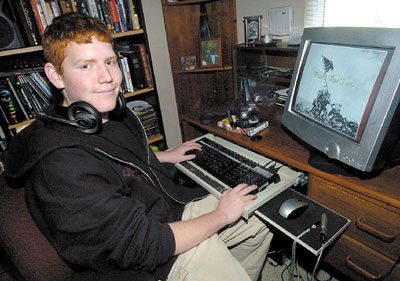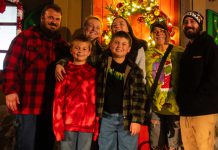Groups and individuals capture the wartime memories of local
veterans of World War II
They sacrificed not only on the battlefield, but in factories and on farms, a nation united against the aggression of foreign powers.
The men and women who came of age during World War II are known as the “greatest generation.” Some became famous, but most were ordinary Americans living in extraordinary times – housewives turned laborers, carpenters turned soldiers, minorities struggling against racial stigmas to serve their country.
Six decades after the war that shaped their lives, a dwindling number of men and women from the greatest generation survive. And a handful of groups and individuals In South County are trying to capture their untold stories, before it’s too late.
“I think sometimes people don’t realize how important they are to history, and that they play a part in history,” said Gilroy Head Librarian Lani Yoshimura, who has established a monthly forum for veterans, widows and others to share war-time memories. “Even what seems to be a small role is a significant role in the fabric of this nation and world.”
A growing number of people have attended the series in recent months, she said. The attendees are a mix of veterans and their relatives, in some cases children hoping to capture the stories of a father who died in battle or passed away before sharing his experiences.
The daughter of one veteran appeared at a meeting in January with her father’s uniform, hoping to glean a few details about his time in the military.
A veteran in the crowd had never met her father, but was able to trace his military career – from his rank to the battles he fought in – based on the medals, stripes and emblems on the uniform.
Another family told the story of how they “adopted” a war hero long estranged from his relatives.
“They never met the man, but they keep a photo album that they show people who come to their house as if he was part of their own family,” Yoshimura said. “I’ve done a lot of programs over the years, but this has touched me more than any other.”
The idea for the program came to Yoshimura based on her own experiences as family historian. She has spent two decades corresponding with the men who fought beside her father, 1st Lt. Akiji Yoshimura, who served as a U.S. military translator while the rest of her family was held in Japanese internment camps.
The meetings help veterans share stories that have been bottled up for years, Yoshimura said.
“We’re probably at a point where people are willing to share,” she said. “We’ve had many veterans say they haven’t even talked about (their experiences) with their families.”
The war still haunts Al Gagliardi, an 82-year-old Army veteran who fought in the Battle of Iwo Jima. To this day, Gagliardi has occasional nightmares, though it was a lot worse in the years immediately after the war.
Gagliardi has spoken to his grandchildren’s classes about World War II, but he rarely goes into details.
“It’s not a big secret, but it’s hard to do,” Gagliardi said, tears forming in his eyes. “I felt bad about what I did. We’re not socialized to kill people.”
That’s not an uncommon feeling said Jim Perales, a Vietnam War veteran and commander of the Veterans of Foreign Wars Post 9242 in Hollister.
He has encountered other veterans with similar feelings, but he said that has not proven the hardest part about gathering their stories.
“I talked to one guy who is in the hospital now,” he said. “Then there is another guy who is going blind. He’s not doing too well right now … I’ve got a list of names of at least eight or nine of them, but it’s hard to get a hold of these people because a lot of them are either sick or they just can’t do it.”
Still, Perales is determined to get a few stories down on paper. He was inspired to gather the histories of local veterans four years ago, when he met a World War II veteran at Fort Ord.
Perales never took down his name, but the details of the story remain vivid.
“He was telling me about his experience in Japan as a prisoner of war, about how cruel the Japanese soldiers were,” Perales recounted. “If someone couldn’t walk or march, how they’d just shoot them. I told him he should write down his story before he dies.”
Alex Bacon had a different motivation for learning how to record oral histories. The 16-year-old Gilroy resident got hooked on World War II history through video games, which led him to speak with teachers, read books and eventually partner with the Digital Clubhouse Network. The organization, based in New York, trains youths across the country to shoot and edit oral histories of veterans, which it then posts on the Internet as part of its Stories of Service program (http://www.stories-of-service.org).
Bacon introduced himself to veterans at the January meeting for veterans at Gilroy Library. He hopes to find a few willing volunteers to share their stories by this summer, when he plans to dive headlong into the project.
“The point of Stories of Service is to really find a short personal story that changed their lives or their outlook on life,” Bacon explained. “Some stories are from people who stayed behind. They’re telling the story of a relative who didn’t come back in some cases, and people who worked in factories to support the war effort.”
Eleanor Frusetta, 81, remembers war-time in Gilroy. Each family had a booklet of stamps to track how much food they received, as part of the federal government’s efforts to ration. She and other girls in her Gilroy High School class would get bussed to farms to pick vegetables, since so many men were fighting abroad. And she remembers anxiously awaiting the newsreel at the Strand Theater in downtown Gilroy.
News of the war came quickest and most vividly at the theater, and Frusetta was eager to hear the updates – she had three brothers fighting in the war, and letters often took months to travel between them.
Al Gagliardi was the youngest of her brothers, and Frusetta recalled how her mom ripped up his enlistment papers when he tried to join the Army in high school (he was eventually drafted).
“She had two boys working for Uncle Sam and she wanted to keep one home,” Frusetta explained. “When he left, it was like I had lost a limb.”
Though Gagliardi returned from the war, they lost one brother, Sal, in Germany toward the end of fighting in 1945.
In the years after the war, Frusetta was among the women who worked with local veterans groups to found a monthly reunion dinner for widows, sisters, veterans and other survivors of the war.
Fewer and fewer people show up at the events, Frusetta said, but they continue to hold them.
“We didn’t want them to be forgotten,” she said.
Bud Flaherty still has vivid memories of his own service during the war. The 91-year-old former Army engineer stuck on a remote island at the tip of Alaska, building an airfield for the military.
When he got drafted, he was forced to give up $200 a month in pay for the $21 monthly wages paid by the Army. He didn’t mind serving, though he said that people at home did not always appreciate the sacrifice.
“When the war started, everybody would buy you a drink,” Flaherty said. “You couldn’t go someplace without someone buying you one. But when you got back, they wanted you to buy them one. People forget pretty quick.”
Lawson Sakai, another Morgan Hill, resident, has worked to ensure that people do not forget a particular strand of history – that of Japanese-Americans during World War II. Four years ago, the 83-year-old veteran helped enshrine that history in an exhibit at the Buddhist Community Center, on Murphy Avenue.
It is a conflicted history, Sakai said, a time when, despite having their livelihoods taken from them, thousands of second-generation Japanese men born in America – known as Nisei – made the ultimate sacrifice for a country that had rounded them up into internment camps.
“Everything was taken away from you,” Sakai said. “Your home, your work, school. And you were treated as an enemy alien, even if you were raised here. It was a pretty bitter time, just to have your heart ripped out for no reason except that you look like what they perceived to be their enemy. You know, when I looked in the mirror, all I saw was an American.”
Sakai was among the roughly 4,000 Nisei who distinguished themselves in the 442nd Regiment, an all-Japanese combat team that sustained severe casualties in the famed Rescue of the Lost Battalion. Like many others in his regiment, Sakai suffered an injury and still returned to combat, and a few days later had shrapnel tear through his body and end his military career. Despite the discrimination of the time, regiment’s valor helped re-open the door to other branches of the military for Japanese Americans.
Brian Shiroyama, curator of the exhibit, said it honors local veterans from Morgan Hill to Hollister. The exhibit was unveiled four years ago at the center’s annual spring festival, and residents will again have a chance to view it at the next festival on April 15.
“We kept that as our permanent exhibit so we could continue to tell the story about our veterans,” Shiroyama said. “All these guys are really getting up in age now and so many people are passing on. We wanted to keep their legacy going.”
Teen Seeks WWII Veterans’ Stories
By Serdar Tumgoren
A local teenager is parlaying his zeal for video games into a mission to preserve the history of a fading generation.
Alex Bacon, a 16-year-old Gilroy resident, is a multimedia whiz and World War II aficionado who recently received training to gather oral histories from war veterans.
“These people are fading fast, and if we lose all their stories, we lose a piece of American history, of world history,” Bacon said. “It’s just something that should be preserved.”
The sophomore at Oakwood Country School, in Morgan Hill, became interested in conducting oral histories through an unusual path.
“I play a lot of World War II video games,” Bacon said. “I’d be playing them and I’d wonder, ‘What’s the story behind all this?’ I talked to my friends and teachers and they filled me in. The more I learned, the more I got interested in it. I’ve read books, watched shows on the History Channel, all sorts of sources.”
Since the age of 12, Bacon also has helped produce and air shows on community access television. Last summer, he decided to combine his love of history with his video skills by working with the Digital Clubhouse Network.
The organization, based in New York, trains youths across the country to shoot and edit oral histories, which it then posts on the Internet as part of its Stories of Service program (http://www.stories-of-service.org).
“They gave us some advice from their own personal experience,” Bacon said. “They said there are two extremes: Either (veterans) would talk to us non-stop, or they’d be extremely shy. They said not to be scared to ask, but if it’s obvious they’re uncomfortable with it, to back off.”
So far, Bacon has only conducted one oral history with his stepfather’s dad. Speaking last year from a hospital bed in Las Vegas, Bacon’s ailing relative still found it difficult to open up about his experience.
“We went there and my stepfather asked him most of the questions and I was taking notes. It was kind of a delicate situation,” Bacon said, adding that his relative passed away a few weeks later.
Now, Bacon is determined to help others capture the stories of their relatives before it is too late. In January, he introduced himself at a veterans forum sponsored by the Gilroy Public Library. He hopes to find a few volunteers to share their stories by this summer.
Getting veterans to discuss their experiences is not always easy, said Gilroy Head Librarian Lani Yoshimura. She has spent 20 years corresponding with the men who served with her father during World War II, and many have not even related their war-time memories to family.
Bacon, she hopes, will break through the emotional wall and capture a few stories.
“I’ve noticed that some of the veterans don’t want to talk about this, but in some ways it’s not as difficult to talk to the kids, because there’s a teaching element to it,” Yoshimura said. “And it’s more neutral, because they’re not their family. I think it’s a wonderful joining of age groups and interests, and a way to bring this gift of knowledge to families that don’t know what a dad or grandpa did at a certain time in their lives.”
Veterans interested in telling the story of how the war changed their lives should contact Bacon at 848-1881.














